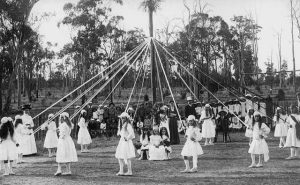
Britain’s many traditions and customs reflect the country’s rich cultural history. These celebrations are almost all tied to the agricultural calendar, local folklore, religious festivals, historical events, or communal identity. However, the relatively recent past has seen Britain undergo major technological advances, rapid urbanisation and mass immigration. These developments have fuelled a tremendous shift in Britain’s social norms. As a result, once well-supported customs and traditions are increasingly being forgotten.
Here’s a brief account of the once-popular tradition of maypole dancing:
The Maypole Dance
The maypole dance is a traditional European folk dance that typically celebrates the arrival of spring. In Britain, the dance is strongly associated with the May Day (1 May) celebrations. The maypole is often brightly painted or decorated with greenery and flowers in preparation for the celebratory dance. In some parts of Europe, the dance is also performed to mark other seasonal festivities such as midsummer.

Photo Credit: Creative Commons – PDM 1.0
A Brief History of Maypole Dancing
The origins of the maypole can be traced back to the pagan festivals of pre-Christian times. Originally, a tall, straight, living tree, the maypole was viewed as a symbol of fertility and renewal. Later, a tall wooden pole would replace the tree as the maypole. By the 14th century, the maypole dance had become specifically linked with the Spring Festival. The dance involves participants frolicking around a pole while simultaneously weaving coloured ribbons. Primarily, the dance was a celebration of the arrival of the new season and warmer weather. Over time, performing the maypole dance on the first day of May became the common practice.
By the 16th century, the custom of maypole dancing had become well-established throughout much of Britain. However, in 1645, the puritanical leader of the New Model Army, Oliver Cromwell, took control of the country. He brought the May Day festivities to an abrupt end, describing maypole dancing as ”a heathenish vanity generally abused to superstition and wickedness’’. New legislation saw village maypoles being taken down across the length and breadth of the country.
In 1660, the restoration of the crown saw May Day celebrations return to village greens once again. The new monarch, Charles II, keen to win favour with his new subjects, ordered the erection of a 40 m-high maypole in London’s Strand. The pole was viewed as a symbol of a new start and potentially happier times for Britain. It stood in place for some 50 years.
From the mid-18th century, the popularity of maypole dancing began to decline steadily. The primary reason was the mass migration of the country’s population from rural to urban living during the onset of the Industrial Revolution. The 19th century saw a limited revival of maypole dancing when it became a popular spectacle at folk festivals and school celebrations.
Maypole Dancing Today
Today in Britain, maypole dancing is still performed at some schools and community gatherings. However, in general, its popularity is very much on the wane.
Header Image Credit: Creative Commons – PDM 1.0





